The intelligent garment hanging conveyor system market is expected to grow from USD 230.9 million in 2025 to USD 335.3 million by 2035, reflecting a CAGR of 3.8%. The market growth curve demonstrates a steady upward trajectory, indicating consistent adoption across industrial and retail segments. In the initial phase, from 2025 to 2028, growth is driven by the integration of automated material handling solutions in apparel manufacturing and retail distribution centers. Manufacturers increasingly focus on reducing labor costs, enhancing operational efficiency, and improving workflow precision, which results in a gradual but noticeable incline in the growth curve.
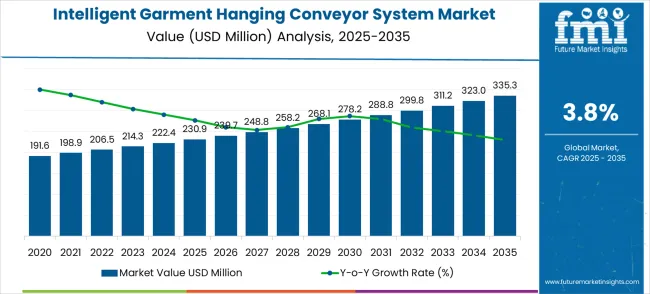
Between 2028 and 2032, the curve maintains a moderate slope as adoption expands into mid-sized facilities and regional markets. Incremental growth during this period is supported by enhancements in system flexibility, energy efficiency, and real-time monitoring capabilities, making these solutions attractive for broader industrial applications. From 2032 to 2035, growth continues steadily as replacement cycles, technology upgrades, and regional penetration sustain momentum. The overall shape of the growth curve highlights a market characterized by gradual expansion rather than sharp fluctuations, reflecting predictable adoption patterns and a stable trajectory. This analysis allows stakeholders to align investment, production, and product development strategies with long-term market trends.
The intelligent garment hanging conveyor system market is distributed across apparel manufacturing and processing units (38%), retail and distribution centers (27%), logistics and e-commerce fulfillment centers (17%), dry cleaning and laundry services (10%), and specialty applications such as exhibition and display setups (8%). Apparel manufacturing facilities lead adoption due to the need for automated handling, sorting, and efficient movement of garments along production lines. Retail and distribution centers use these systems to optimize inventory handling and reduce labor-intensive processes. Logistics and e-commerce fulfillment centers leverage them for rapid sorting and dispatch. Dry cleaning and laundry services adopt hanging conveyors for streamlined operations, while specialty applications include fashion exhibitions and large-scale display setups.
Current trends involve automation-enabled conveyors, IoT-based tracking, and modular designs for scalability. Manufacturers are innovating with energy-efficient motors, noise reduction technologies, and intelligent routing algorithms to improve operational efficiency. Expansion into fast-fashion production, centralized garment distribution, and smart warehouse solutions is driving market adoption. Partnerships between conveyor system providers and apparel or logistics operators enable customized solutions for precision, throughput, and reduced handling errors, supporting global growth.
| Metric | Value |
|---|---|
| Market Value (2025) | USD 230.9 million |
| Market Forecast (2035) | USD 335.3 million |
| Growth Rate | 3.8% CAGR |
| Leading Technology | Fully Automatic System Type |
| Primary Application | Garment Manufacturing Industry Segment |
The market demonstrates strong fundamentals with fully automatic system types capturing a dominant share through advanced automation and intelligent tracking capabilities. Garment Manufacturing Industry applications drive primary demand, supported by increasing textile automation spending and production efficiency modernization. Geographic expansion remains concentrated in developed markets with established textile manufacturing infrastructure, while emerging economies show accelerating adoption rates driven by industrial modernization and rising manufacturing automation investments.
Market expansion rests on three fundamental shifts driving adoption across textile and logistics sectors. Manufacturing automation demand creates compelling operational advantages through intelligent conveyor systems that provide automated material handling and production flow optimization without manual intervention, enabling facilities to maximize throughput efficiency while maintaining quality standards and reducing labor costs.
Textile manufacturing modernization programs accelerate as garment producers worldwide seek advanced material handling equipment that complements existing production systems, enabling precise garment tracking and workflow management applications that align with Industry 4.0 standards and operational efficiency requirements.
Supply chain optimization drives adoption from textile manufacturers and logistics facilities requiring reliable conveyor solutions that minimize handling errors while maintaining production productivity during garment processing and distribution operations.
The growth faces headwinds from integration complexity challenges that vary across different manufacturing environments regarding system compatibility and operational protocols, potentially limiting deployment flexibility in certain textile production facilities. Technical limitations also persist regarding throughput capacity variations and environmental conditions that may reduce system performance in high-humidity textile processing environments or facilities with space constraints that affect conveyor layout optimization.
The intelligent garment hanging conveyor system market is positioned for significant growth and technological evolution. As textile manufacturers, apparel producers, and logistics operators across both developed and emerging markets seek automation solutions that offer precision tracking, operational efficiency, production optimization, and intelligent control capabilities, garment hanging conveyor systems are gaining prominence not just as basic material handling equipment but as strategic automation components in textile production lines, warehouse operations, quality control systems, and integrated manufacturing platforms.
Rising industrial automation investments and textile modernization programs in Asia-Pacific, Europe, and North America amplify demand, while manufacturers are capitalizing on innovations in intelligent tracking technology, IoT integration, and production management systems. Pathways like smart automation, precision control, and environmental-focused solutions promise strong margin uplift, especially in mature textile manufacturing markets. Geographic expansion and localization will capture volume, particularly where textile production is growing or automation infrastructure is developing. Regulatory pressures around workplace safety, production efficiency, quality standards, and manufacturing optimization give structural support.
Primary Classification: The market segments by system type into fully automatic system, Semi-Automatic System, and Others categories, representing the evolution from operator-assisted systems to intelligent automation solutions for comprehensive garment handling applications.
Secondary Breakdown: Application segmentation divides the market into Garment Manufacturing Industry, Warehousing and Logistics sectors, reflecting distinct requirements for textile production operations, distribution centers, and material handling applications requiring automated conveyor solutions.
Regional Classification: Geographic distribution covers Asia Pacific, Europe, North America, Latin America, and the Middle East & Africa, with developed markets leading adoption while emerging economies show accelerating growth patterns driven by textile manufacturing modernization programs.
The segmentation structure reveals technology progression from semi-automatic operator-controlled systems toward fully integrated intelligent platforms with enhanced automation and tracking capabilities, while application diversity spans from textile manufacturing operations to specialized warehousing and logistics applications requiring reliable conveyor handling solutions.
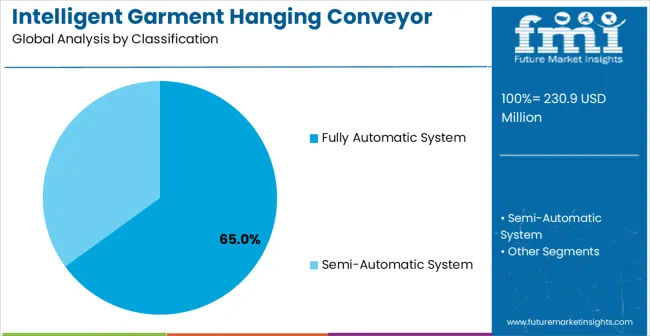
Market Position: Fully Automatic Systems command the leading position in the Intelligent Garment Hanging Conveyor System market with approximately 65% market share through advanced automation features, including intelligent tracking systems, automated routing, and integrated production control that enable unmanned operation across diverse textile manufacturing environments.
Value Drivers: The segment benefits from textile manufacturer preference for automated systems that provide consistent material handling performance without requiring operator intervention or manual sorting. Advanced tracking features enable deployment in garment production facilities, distribution centers, and logistics operations where precision and throughput represent critical operational requirements.
Competitive Advantages: Fully automatic systems differentiate through intelligent control capability, automated routing features, and integration with manufacturing execution systems that enhance production efficiency while maintaining consistent performance profiles suitable for continuous operation in textile facilities.
Key market characteristics:
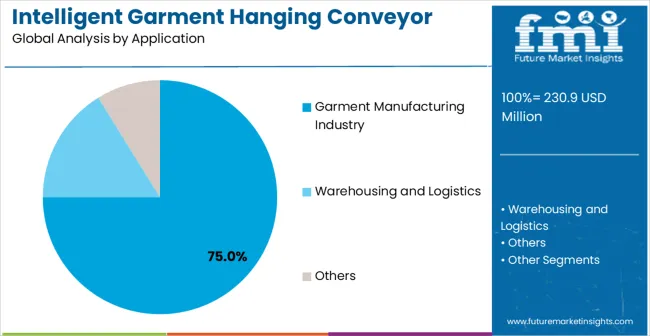
Market Context: Garment Manufacturing Industry applications dominate the intelligent garment hanging conveyor system market with approximately 75% market share due to widespread adoption in textile production facilities, apparel manufacturers, and garment processing operations that require automated material handling, production tracking, and workflow optimization applications that maximize operational efficiency while maintaining product quality standards.
Appeal Factors: Garment manufacturing customers prioritize system reliability, throughput capacity, and integration with existing production infrastructure that enables coordinated operation across multiple manufacturing processes. The segment benefits from substantial textile automation investments and modernization programs that emphasize advanced material handling equipment acquisition for production efficiency and quality control operations.
Growth Drivers: Textile manufacturing modernization programs incorporate intelligent conveyor systems as standard equipment for garment tracking and production flow applications. At the same time, apparel manufacturing automation initiatives are increasing demand for intelligent routing capabilities that integrate with production planning systems and minimize production bottlenecks.
Market Challenges: Production specification requirements and textile industry standards may limit operational flexibility in certain manufacturing environments or specialized applications with unique throughput capacity demands or space constraints.
Application dynamics include:
Textile manufacturing automation drives primary adoption as intelligent conveyor systems provide automated material handling capabilities that enable optimized production flow without manual intervention, supporting garment manufacturing operations and assembly processes that require consistent tracking accuracy and throughput optimization. Manufacturing infrastructure demand accelerates market expansion as textile facilities seek reliable conveyor solutions that minimize handling errors while maintaining operational efficiency during garment processing and production workflow management. Automation spending increases worldwide create steady demand for intelligent conveyor systems that complement manufacturing automation and provide operational flexibility in complex textile production environments.
Growth Inhibitors Integration complexity challenges persist regarding system compatibility and operational protocols that may limit deployment effectiveness in diverse textile manufacturing environments, legacy production facilities, or specialized garment processing operations that require custom conveyor configurations and integration approaches. Market fragmentation across multiple textile industry specifications and production standards creates compatibility concerns between different system manufacturers and existing manufacturing infrastructure, potentially limiting integration flexibility and standardization efforts.
Adoption accelerates in textile manufacturing and logistics sectors where automation benefits justify system costs, with geographic concentration in developed markets transitioning toward mainstream adoption in emerging economies driven by manufacturing modernization and textile production infrastructure development. Technology development focuses on enhanced tracking capabilities, improved energy efficiency, and integration with manufacturing execution systems that optimize production monitoring and workflow management effectiveness. The market could face disruption if alternative material handling technologies or production methodologies significantly alter textile manufacturing processes or conveyor system requirements in garment production applications.
The Intelligent Garment Hanging Conveyor System market demonstrates varied regional dynamics with Growth Leaders including China (5.1% CAGR) and India (4.8% CAGR) driving expansion through textile manufacturing modernization and production infrastructure development. Steady Performers encompass Germany (4.4% CAGR), Brazil (4.0% CAGR), and the USA (3.6% CAGR), benefiting from established textile industries and advanced automation technology adoption. Emerging Markets feature the UK (3.2% CAGR) and Japan (2.9% CAGR), where specialized manufacturing applications and production technology integration support consistent growth patterns.
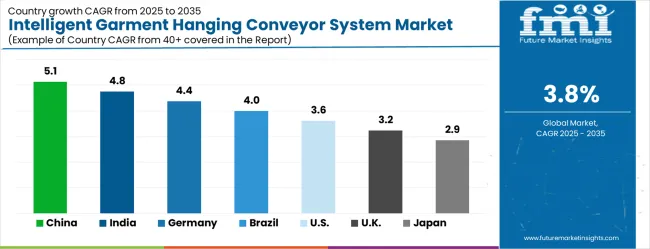
| Country | CAGR (2025-2035) |
|---|---|
| China | 5.1% |
| India | 4.8% |
| Germany | 4.4% |
| Brazil | 4.0% |
| USA | 3.6% |
| UK | 3.2% |
| Japan | 2.9% |
Regional synthesis reveals Asia-Pacific markets leading growth through textile manufacturing modernization and production infrastructure development, while European countries maintain steady expansion supported by automation technology advancement and textile industry standardization requirements. North American markets show moderate growth driven by manufacturing automation applications and production technology integration trends.
China establishes market leadership through aggressive textile manufacturing modernization programs and comprehensive production infrastructure development, integrating advanced intelligent conveyor systems as standard components in garment processing operations and material handling applications. The country's 5.1% CAGR through 2035 reflects government initiatives promoting textile automation and domestic manufacturing capabilities that mandate advanced conveyor systems in garment production facilities and textile manufacturing installations. Growth concentrates in major textile manufacturing centers, including Guangdong, Jiangsu, and Zhejiang, where production automation development showcases integrated conveyor systems that appeal to domestic textile manufacturers seeking advanced material handling capabilities and production efficiency applications.
Chinese manufacturers are developing cost-effective intelligent conveyor solutions that combine domestic production advantages with advanced features, including automated tracking systems and enhanced throughput capabilities. Distribution channels through textile equipment suppliers and automation system integrators expand market access while government funding for manufacturing technology development supports adoption across diverse textile and garment manufacturing segments.
Strategic Market Indicators:
In Mumbai, Bangalore, and Chennai, textile manufacturing and garment processing facilities are implementing advanced intelligent conveyor systems as standard equipment for production operations and material handling applications, driven by increasing textile automation spending and modernization programs that emphasize automated tracking capabilities. The market is projected to demonstrate a 4.8% CAGR through 2035, supported by government textile initiatives and infrastructure development programs that promote advanced automation equipment for textile and garment manufacturing facilities. Indian textile companies are adopting intelligent conveyor systems that provide automated material handling capabilities and production tracking features, particularly appealing in garment manufacturing regions where efficiency represents critical operational requirements.
Market expansion benefits from growing textile automation capabilities and international technology transfer agreements that enable domestic production of advanced conveyor systems for textile manufacturing and garment processing applications. Technology adoption follows patterns established in textile automation, where efficiency and reliability drive procurement decisions and operational deployment.
Market Intelligence Brief:
The advanced textile technology market in Germany demonstrates sophisticated intelligent conveyor deployment with documented operational effectiveness in garment manufacturing and material handling applications through integration with existing production systems and automation infrastructure. The country leverages engineering expertise in conveyor technology and textile automation integration to maintain a 4.4% CAGR through 2035. Manufacturing centers, including Bavaria, Baden-Württemberg, and North Rhine-Westphalia, showcase premium installations where intelligent conveyor systems integrate with comprehensive automation platforms and production management systems to optimize manufacturing efficiency and material handling effectiveness.
German textile equipment manufacturers prioritize system reliability and European automation standards in intelligent conveyor development, creating demand for premium systems with advanced features, including environmental durability and integration with Industry 4.0 manufacturing systems. The market benefits from established textile automation infrastructure and willingness to invest in advanced conveyor technologies that provide long-term operational benefits and compliance with international quality requirements.
Market Intelligence Brief:
The market expansion in brazil benefits from diverse textile demand, including garment manufacturing modernization in São Paulo and Rio de Janeiro, textile industry equipment upgrades, and government industrial programs that increasingly incorporate advanced automation solutions for textile production applications. The country maintains a 4.0% CAGR through 2035, driven by rising textile automation investments and increasing awareness of intelligent conveyor technology benefits, including automated tracking and enhanced production efficiency capabilities.
Market dynamics focus on cost-effective conveyor solutions that balance advanced automation features with affordability considerations important to Brazilian textile manufacturers. Growing textile industrialization creates steady demand for modern material handling systems in new manufacturing facilities and production equipment modernization projects.
Strategic Market Considerations:
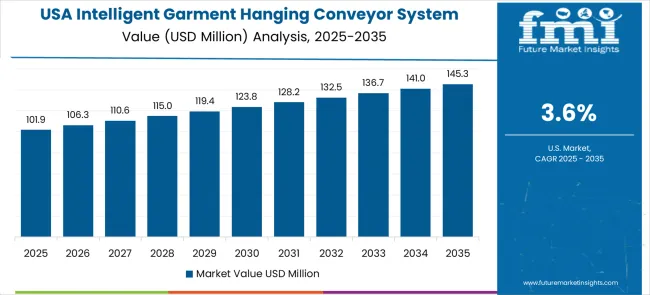
The USA market emphasizes advanced intelligent conveyor features, including automated tracking systems and integration with comprehensive manufacturing platforms that manage material handling, production operations, and workflow optimization applications through unified automation systems. The country is projected to show a 3.6% CAGR through 2035, driven by textile manufacturing modernization under industrial equipment upgrades and commercial facility demand for reliable automation systems. American textile facilities prioritize operational effectiveness with intelligent conveyor systems delivering consistent material handling performance through advanced tracking algorithms and production integration capabilities.
Technology deployment channels include major textile equipment suppliers, specialized automation system integrators, and commercial procurement programs that support professional installation for complex manufacturing applications. Manufacturing platform integration capabilities with established automation systems expand market appeal across diverse operational requirements seeking efficiency and reliability benefits.
Performance Metrics:
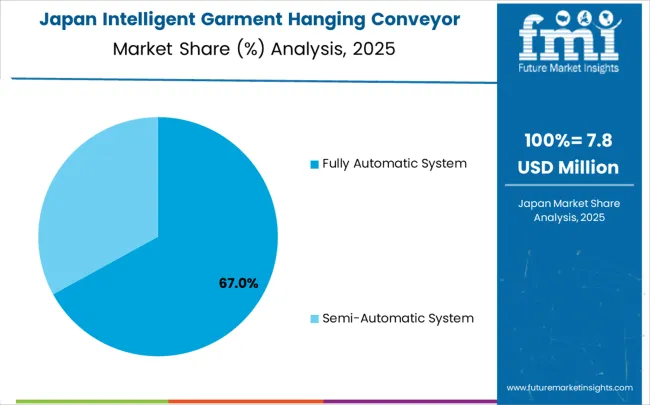
Japan demonstrates steady market development with a 2.9% CAGR through 2035, distinguished by textile manufacturing industries' preference for high-quality intelligent conveyor systems that integrate seamlessly with existing automation systems and provide reliable long-term operation in specialized garment processing applications. The market prioritizes advanced features, including precision tracking, environmental durability, and integration with comprehensive manufacturing platforms that reflect Japanese textile industry expectations for technological sophistication and operational excellence.
In Manchester, Birmingham, and other textile manufacturing centers, British garment processing facilities and automation companies are implementing advanced intelligent conveyor systems to enhance production capabilities and support manufacturing operations that align with Industry 4.0 requirements and automated tracking protocols. The UK market demonstrates sustained growth with a 3.2% CAGR through 2035, driven by textile modernization programs and manufacturing equipment upgrades that emphasize advanced automation systems for textile and garment processing applications. British textile facilities are prioritizing intelligent conveyor systems that provide automated material handling capabilities while maintaining compliance with quality regulations and minimizing operational risks, particularly important in garment manufacturing and textile processing operations.
Market expansion benefits from government textile development programs that mandate automation capabilities in manufacturing equipment specifications, creating sustained demand across the UK's textile and garment manufacturing sectors where operational efficiency and tracking represent critical requirements. The regulatory framework supports intelligent conveyor adoption through textile equipment standards and quality requirements that promote advanced automation systems aligned with European manufacturing capabilities.
Strategic Market Indicators:
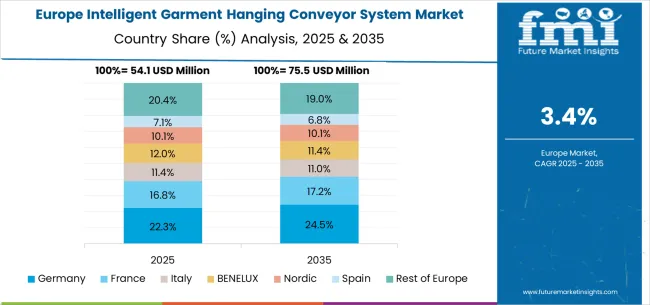
The European Intelligent Garment Hanging Conveyor System market is projected to grow from USD 49.3 million in 2025 to USD 71.6 million by 2035, registering a CAGR of 3.8% over the forecast period. Germany is expected to maintain its leadership position with a 32.1% market share in 2025, declining slightly to 31.7% by 2035, supported by its advanced textile manufacturing infrastructure and major industrial centers, including Bavaria and Baden-Württemberg.
France follows with a 18.6% share in 2025, projected to reach 18.9% by 2035, driven by comprehensive textile modernization programs and automation technology development initiatives. The United Kingdom holds a 16.4% share in 2025, expected to maintain 16.1% by 2035 through specialized manufacturing applications and European standardization requirements. Italy commands a 13.8% share, while Spain accounts for 9.7% in 2025. The Rest of Europe region is anticipated to gain momentum, expanding its collective share from 9.4% to 10.6% by 2035, attributed to increasing intelligent conveyor adoption in Nordic countries and emerging Eastern European textile manufacturing facilities implementing industrial modernization programs.
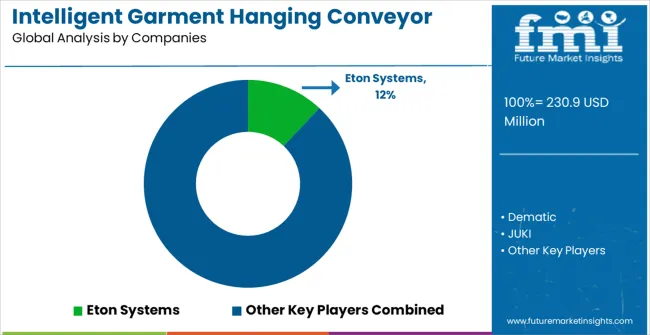
The Intelligent Garment Hanging Conveyor System market operates with moderate concentration, featuring approximately 18-22 meaningful participants, where leading companies control roughly 50-55% of the global market share through established textile automation relationships and comprehensive technology portfolios. Eton Systems maintains the leading market share with approximately 12-15% of the global market, followed by Dematic with 10-12% market share, while JUKI holds 8-10% market share position. Competition emphasizes advanced tracking capabilities, system reliability, and manufacturing platform integration rather than price-based rivalry.
Market Leaders encompass Eton Systems (12-15% market share), Dematic (10-12% market share), and JUKI (8-10% market share), which maintain competitive advantages through extensive textile automation expertise, global equipment supplier networks, and comprehensive system integration capabilities that create customer switching costs and support premium pricing. These companies leverage decades of material handling technology experience and ongoing research investments to develop advanced conveyor systems with intelligent tracking and environmental durability features.
Technology Challengers include Dürkopp Fördertechnik (KNAPP), NEDCON, and Psb Intralogistics, which compete through specialized conveyor technology focus and innovative automation interfaces that appeal to textile customers seeking advanced tracking capabilities and operational flexibility. These companies differentiate through rapid technology development cycles and specialized manufacturing application focus.
Regional Specialists feature companies like SSI SCHAEFER, Schönenberger Systeme, and SmartMRT, which focus on specific geographic markets and specialized applications, including intelligent control systems and integrated automation solutions. Market dynamics favor participants that combine reliable conveyor hardware with advanced tracking software, including automated routing and production integration capabilities. Competitive pressure intensifies as traditional material handling companies expand into intelligent conveyor systems. At the same time, specialized textile automation manufacturers challenge established players through innovative tracking solutions and cost-effective platforms targeting specialized textile manufacturing segments.
| Item | Value |
|---|---|
| Quantitative Units | USD 230.9 million |
| System Type | Fully Automatic System, Semi-Automatic System, Others |
| Application | Garment Manufacturing Industry, Warehousing and Logistics |
| Regions Covered | Asia Pacific, Europe, North America, Latin America, Middle East & Africa |
| Countries Covered | China, India, Germany, Brazil, the USA, the UK, Japan, and 25+ additional countries |
| Key Companies Profiled | Eton Systems, Dematic, JUKI, Dürkopp Fördertechnik (KNAPP), NEDCON, Psb Intralogistics, SSI SCHAEFER, Schönenberger Systeme |
| Additional Attributes | Dollar sales by system type and application categories, regional adoption trends across Asia Pacific, Europe, and North America, competitive landscape with textile automation companies and technology providers, garment manufacturing preferences for intelligent tracking and system reliability, integration with textile production platforms and automation systems, innovations in conveyor technology and automated tracking algorithms, and development of fully automatic solutions with enhanced throughput and operational capabilities. |
How big is the intelligent garment hanging conveyor system market in 2025?
The global intelligent garment hanging conveyor system market is valued at USD 230.9 million in 2025.
What will be the size of the intelligent garment hanging conveyor system market in 2035?
The size of the intelligent garment hanging conveyor system market is projected to reach USD 335.3 million by 2035.
How much will the intelligent garment hanging conveyor system market grow between 2025 and 2035?
The intelligent garment hanging conveyor system market is expected to grow at a 3.8% CAGR between 2025 and 2035.
What are the key system type segments in the intelligent garment hanging conveyor system market?
The key system type segments in the intelligent garment hanging conveyor system market are Fully Automatic System, Semi-Automatic System, and Others.
Which application segment is expected to contribute a significant share to the intelligent garment hanging conveyor system market in 2025?
In terms of application, the Garment Manufacturing Industry segment is set to command the dominant share in the Intelligent Garment Hanging Conveyor System market in 2025.
The global intelligent garment hanging conveyor system market is estimated to be valued at USD 230.9 million in 2025.
The market size for the intelligent garment hanging conveyor system market is projected to reach USD 335.3 million by 2035.
The intelligent garment hanging conveyor system market is expected to grow at a 3.8% CAGR between 2025 and 2035.
The key product types in intelligent garment hanging conveyor system market are fully automatic system and semi-automatic system.
In terms of application, garment manufacturing industry segment to command 75.0% share in the intelligent garment hanging conveyor system market in 2025.






Our Research Products

The "Full Research Suite" delivers actionable market intel, deep dives on markets or technologies, so clients act faster, cut risk, and unlock growth.

The Leaderboard benchmarks and ranks top vendors, classifying them as Established Leaders, Leading Challengers, or Disruptors & Challengers.

Locates where complements amplify value and substitutes erode it, forecasting net impact by horizon

We deliver granular, decision-grade intel: market sizing, 5-year forecasts, pricing, adoption, usage, revenue, and operational KPIs—plus competitor tracking, regulation, and value chains—across 60 countries broadly.

Spot the shifts before they hit your P&L. We track inflection points, adoption curves, pricing moves, and ecosystem plays to show where demand is heading, why it is changing, and what to do next across high-growth markets and disruptive tech

Real-time reads of user behavior. We track shifting priorities, perceptions of today’s and next-gen services, and provider experience, then pace how fast tech moves from trial to adoption, blending buyer, consumer, and channel inputs with social signals (#WhySwitch, #UX).

Partner with our analyst team to build a custom report designed around your business priorities. From analysing market trends to assessing competitors or crafting bespoke datasets, we tailor insights to your needs.
Supplier Intelligence
Discovery & Profiling
Capacity & Footprint
Performance & Risk
Compliance & Governance
Commercial Readiness
Who Supplies Whom
Scorecards & Shortlists
Playbooks & Docs
Category Intelligence
Definition & Scope
Demand & Use Cases
Cost Drivers
Market Structure
Supply Chain Map
Trade & Policy
Operating Norms
Deliverables
Buyer Intelligence
Account Basics
Spend & Scope
Procurement Model
Vendor Requirements
Terms & Policies
Entry Strategy
Pain Points & Triggers
Outputs
Pricing Analysis
Benchmarks
Trends
Should-Cost
Indexation
Landed Cost
Commercial Terms
Deliverables
Brand Analysis
Positioning & Value Prop
Share & Presence
Customer Evidence
Go-to-Market
Digital & Reputation
Compliance & Trust
KPIs & Gaps
Outputs
Full Research Suite comprises of:
Market outlook & trends analysis
Interviews & case studies
Strategic recommendations
Vendor profiles & capabilities analysis
5-year forecasts
8 regions and 60+ country-level data splits
Market segment data splits
12 months of continuous data updates
DELIVERED AS:
PDF EXCEL ONLINE
Intelligent Touch Screen Cash Register Market Size and Share Forecast Outlook 2025 to 2035
Intelligent Road Test Instruments Market Size and Share Forecast Outlook 2025 to 2035
Intelligent Driving Technology Solution Market Size and Share Forecast Outlook 2025 to 2035
Intelligent Completion Market Size and Share Market Forecast and Outlook 2025 to 2035
Intelligent Rubber Tracks Market Size and Share Forecast Outlook 2025 to 2035
Intelligent Cervical Massager Market Size and Share Forecast Outlook 2025 to 2035
Intelligent Multifunctional Laser Bird Repeller Market Size and Share Forecast Outlook 2025 to 2035
Intelligent Platform Management Interface (IPMI) Market Size and Share Forecast Outlook 2025 to 2035
Intelligent Flow Meter Market Size and Share Forecast Outlook 2025 to 2035
Intelligent Lighting Control Market Size and Share Forecast Outlook 2025 to 2035
Intelligent Enterprise Data Capture Software Industry Analysis in Japan Size and Share Forecast Outlook 2025 to 2035
Intelligent Vending Machine Market Insights – Demand, Size & Industry Trends 2025–2035
Intelligent Virtual Store Design Solution Market Size and Share Forecast Outlook 2025 to 2035
Intelligent Enterprise Data Capture Software Market Size, Growth, and Forecast 2025 to 2035
Intelligent Fencing Market Size and Share Forecast Outlook 2025 to 2035
Intelligent Packaging Market Analysis - Size, Share, and Forecast Outlook 2025 to 2035
Intelligent Enterprise Data Capture Software Market in Korea – Trends & Forecast 2025 to 2035
Intelligent Power Module Market Trends - Growth & Forecast 2025 to 2035
Intelligent Prosthetics Market Analysis - Size, Share, and Forecast 2025 to 2035
Intelligent Traffic Management Market Trends – Growth & Forecast 2024 to 2034

Thank you!
You will receive an email from our Business Development Manager. Please be sure to check your SPAM/JUNK folder too.
Chat With
MaRIA